Marine Animal Veterinarian: Student Internship at Gulf World Marine Park
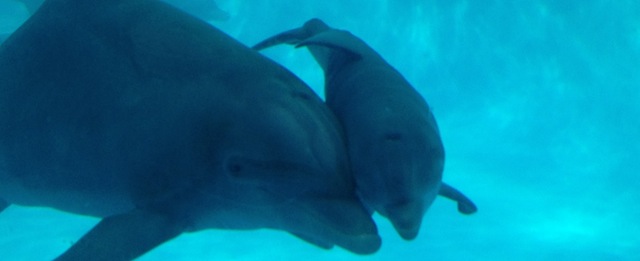
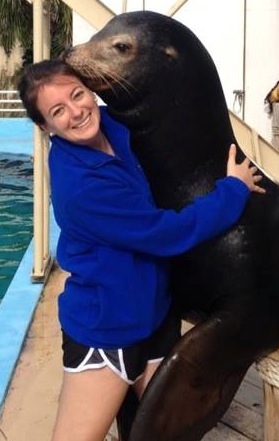 This summer was full of excitement as I was a veterinary intern at Gulf World Marine Park in Panama City Beach, FL. My internship started off with the birth of a female bottlenose dolphin on my first day! Sandy went into labor that morning around 10:00 A.M. and did not have Capri until 3:33 A.M. the next morning.
This summer was full of excitement as I was a veterinary intern at Gulf World Marine Park in Panama City Beach, FL. My internship started off with the birth of a female bottlenose dolphin on my first day! Sandy went into labor that morning around 10:00 A.M. and did not have Capri until 3:33 A.M. the next morning.
This was the first time I had witnessed a live birth, and it was quite the experience. After the birth, we began a 24/7 calf watch. We recorded everything: how long the calf nursed and on which side, any behaviors seen with the mother and the calf, and respiratory rates.
All the information was documented to make sure that mother and calf were doing well and that there was no need for human intervention. There were three calves born over the course of the summer.
Assisting with Stranded Wildlife
Gulf World has created The Gulf World Marine Institute and is involved with the Southeast Marine Mammal Stranding Network and the Sea Turtle Stranding and Salvage Network. Through these partnerships, they are responsible for assisting in the rescue and care of any stranded marine animals within a two hour drive of the park.
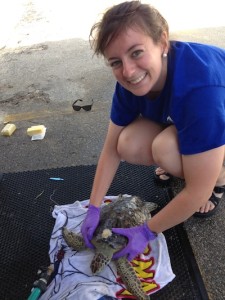 When I arrived, they had a green sea turtle, May Day, who had stranded a week prior with abscesses on his carapace. We also received a Kemps Ridley sea turtle, Miles, who stranded while entangled in monofilament. The monofilament on Miles was pretty deep and we were afraid he might lose his flipper.
When I arrived, they had a green sea turtle, May Day, who had stranded a week prior with abscesses on his carapace. We also received a Kemps Ridley sea turtle, Miles, who stranded while entangled in monofilament. The monofilament on Miles was pretty deep and we were afraid he might lose his flipper.
Both Miles and May Day were successfully released in July. Through this process, I learned how to perform exams on the sea turtles when they come in and how to rehabilitate them.
We got a call one day that a pygmy sperm whale had stranded nearby. We arrived on site and took the animal back to the park. Unfortunately, research has shown that this species does not rehabilitate well and usualyy strand due to cardiomyopathy, other heart related illness, or colonic impactions. Due to this information, the decision was made to humanely euthanize the whale.
After euthanasia a necropsy was performed. I learned how to do a necropsy according to NOAA’s Unusual Mortality Event standards. The necropsy revealed that the colon was severely impacted and his small intestine was quite distended and inflamed. Several of his lymph nodes were also inflamed.
I also had the opportunity to perform a necropsy on a loggerhead sea turtle during my internship. We determined that the turtle had pneumonia after cutting into lungs filled with a caseous substance.
Captive Reptile Medicine
I was able to assist with a surgery on a king snake named Smiley. Smiley had an internal mass removed about five years ago that histopathology revealed to be a renal adenocarcinoma. The mass we removed was similar, and it turned out to be another cancerous growth in his kidney.
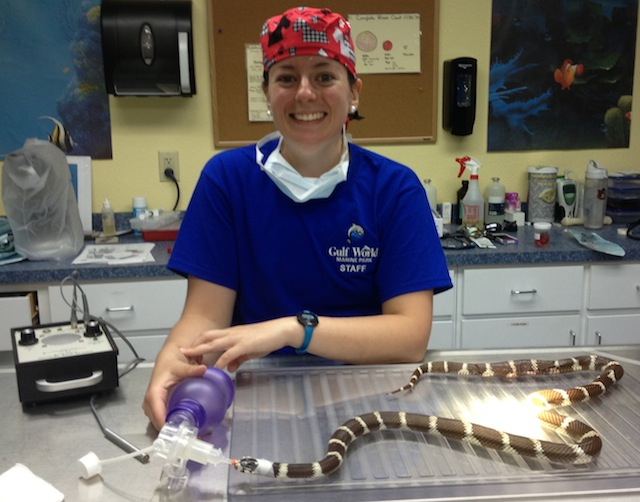
This was the first time I have observed surgery performed on a snake! I monitored anesthesia and gave him artificial breaths throughout the surgery and recovery. I also got to use the Doppler monitor for the first time. It was such a neat machine and the heartbeat was really cool to hear. The Doppler quickly became my favorite thing to share with the kids at vet camp!
Unfortunately one of the red-tailed boa constrictors, Bubba, fell ill this summer. He presented with a history of lethargy and inappetence for about a month’s duration. The caudal half of his body was just hanging there and he was severely dehydrated (when I touched him, my fingerprints stayed visible). Bubba’s lower jaw was extremely swollen, possibly due to edema.
Upon palpation we could feel a mass about 2/3 of the way down the length of his body. We took radiographs of bubba and saw three white circular masses right at his caudal end and then a large 2-3 inch radiopaque structure surrounded by air where we were palpating the mass. We were suspicious of fecaliths and constipation.
Bubba was placed on a strict treatment plan of fluids, enemas, an injectable antibiotic (Fortaz), and a diet of blended rabbit with mineral oil. Over time, many bone-filled fecaliths combined with urates were passed while performing an enema. About 5-6 weeks after initial presentation, surgery was performed on Bubba to remove the bulk of the fecalith that remained. After surgery, Bubba passed a stool by himself in his habitat for the first time in about two months!
Chronic Care Plan for Captive Rough-toothed Dolphin
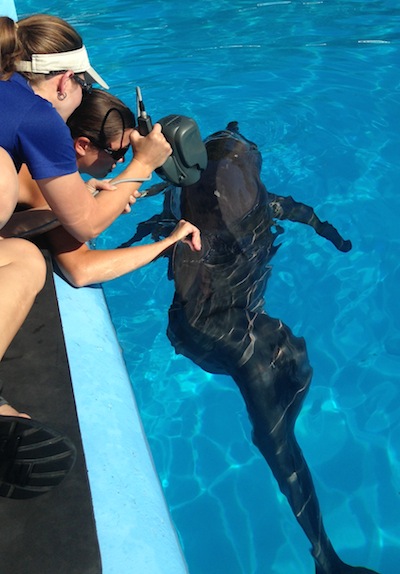
Gulf World is also home to the only collection of rough-toothed dolphins in long-term human care. Among them is Astro, who stranded off the coast of Texas in 2005. Astro was deemed not releasable due to a hearing disability, and he also developed a curvature in his spine shortly after he stranded which has developed into scoliosis.
Part of the treatment plan for his scoliosis includes laser therapy. Laser therapy using a Class 4 laser is a type of therapy utilized at Gulf World. The laser increases blood flow to the tissue and promotes growth and healing while decreasing pain and inflammation. The laser can be used for almost anything from arthritis, scoliosis, and hip dysplasia to pneumonia, scratches, and open wounds. The only things a laser cannot be used on are pregnant animals, fungal infections, thyroid disease, and cancer. We used the laser on almost all the species in the park for the treatment of many different ailments and injuries.
All the Details You Need to Know
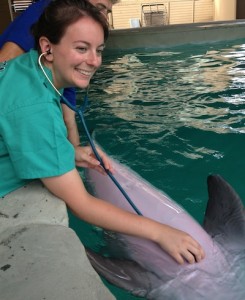 I didn’t have a lot of time away from the park during my internship, considering it was tourist season and we had three babies on 24 hour calf watch. My supervisor tried to give me two days off per week, but sometimes I had to come in on those days to assist with treatments. There is a beach right across the street from the park, and there are lots of restaurants and shops right next door.
I didn’t have a lot of time away from the park during my internship, considering it was tourist season and we had three babies on 24 hour calf watch. My supervisor tried to give me two days off per week, but sometimes I had to come in on those days to assist with treatments. There is a beach right across the street from the park, and there are lots of restaurants and shops right next door.
Housing and transportation are not provided, and the internship is unpaid – but the experience is totally worth it! Fortunately I was able to pay my expenses through my recent acceptance into the Army’s HPSP program and an externship grant from the University of Florida. There is also a scholarship offered by the World Aquatic Veterinary Medical Association that you can apply for as well.
This summer was truly a summer of firsts. The summer after my first year of vet school! The first time I have collected blood from dolphins, penguins, and reptiles. Reading my first cytology slides on dolphin gastric and blowhole samples, participating in my first necropsies, and being so up close and hands-on with marine mammals in a veterinary setting. I could not have dreamed of a better summer experience packed with more learning opportunities if I tried. This was truly my best summer ever!
Elliott here again: Thanks again to Austin for taking the time to write about her experience and share these photos with us! It sounds like she was able to get a lot of hands-on clinical experience with a wide variety of species.
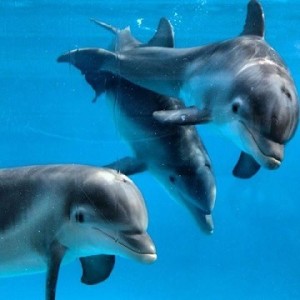 It can be tough to find these types of opportunities before starting clinical rotations in the final year of vet school. You may want to follow Austin’s example in seeking out a slightly less well-known institution, rather than only considering applying to the Sea Worlds and San Diego Zoos of the world.
It can be tough to find these types of opportunities before starting clinical rotations in the final year of vet school. You may want to follow Austin’s example in seeking out a slightly less well-known institution, rather than only considering applying to the Sea Worlds and San Diego Zoos of the world.
You can find more details here about the application process for the various internship options at Gulf World Marine Park. There are 4-6 week externships for veterinary students in clinical rotations, and 8-10 week summer internships for vet students after their first and second years.
The externship grant from the University of Florida’s Aquatics Program will provide $250 per week for up to four weeks. It is open to both UF vet students and also students from other schools who are doing aquatics externships in the state of Florida. Applications are due November 20 and April 20 of each year.
Who else spent their summer working with unique animals like these? Any recommendations on other zoos or marine parks to consider? Let me know if you would like to write about your experience for the blog!
[google-map-v3 width=”350″ height=”350″ zoom=”5″ maptype=”roadmap” mapalign=”center” directionhint=”false” language=”default” poweredby=”false” maptypecontrol=”true” pancontrol=”true” zoomcontrol=”true” scalecontrol=”true” streetviewcontrol=”true” scrollwheelcontrol=”false” draggable=”true” tiltfourtyfive=”false” addmarkermashupbubble=”false” addmarkermashupbubble=”false” addmarkerlist=”Panama City Beach, Florida{}dolphins.png{}#http://www.elliottgarber.com/marine-animal-veterinarian-student-internship-at-gulf-world-marine-park Gulf World Marine Park Internship#” bubbleautopan=”true” showbike=”false” showtraffic=”false” showpanoramio=”false”]


Comments
Hey Elliott (again for tonight haha)
I would love to tell you all about my experiences in my last year of vet school. I have only done 4 out of 50 weeks (graduate next November) but have been doing them at sea world on the gold coast! If you are interested let me know 🙂
Jess – Surfingvet xxx
Definitely interested! I’ll send you an e-mail now. Thank you!
Hey Elliott! I have been replying to your emails but not sure if you have received them? Possibly gone to junk mail? If you haven’t, I am still super keen to have you publish my marine mammal vet experience.
Talk soon 🙂
Jess – surfingvet
i am a student here at whittier MD school, i was wondering if kids can go and help out